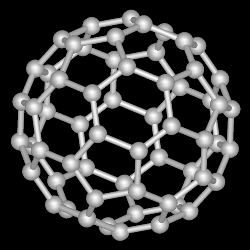Fullerenes
Modification to Reduce Toxicity
“Fullerenes: The simplest C60 fullerene (i.e. the non-polar “buckyball”), when made progressively polar by carboxylation and hydroxylation, also became progressively less cytotoxic to human dermal fibroblasts exposed for 48 hr (Sayes et al. 2004). Comparative molecular dynamics studies of the relative translocation of C60 and its C60(OH)20 derivative across a model cell membrane (dipalmitoylphosphatidylcholine bilayer) are providing a mechanistic explanation for the reduced acute toxicity of functionalized fullerenes (Qiao et al. 2007). These simulations show that the pristine C60 molecule can readily ‘jump’ into the bilayer and translocate across the membrane within a few milliseconds, while the C60(OH)20 molecule barely penetrated the bilayer. These different fullerenes also differentially affected the membrane structure when adsorbed into/onto the phospholipid bilayer.”2
Additional Resources:
- Interim Report of the New Energy and Industrial Technology Development Organization (NEDO), Japan, entitled, “Risk Assessment of Manufactured Nanomaterials - Fullerenes (C60) (928 Kb), issued on October 16, 2009.
References:
1. Photo Credit: Wikimedia Commons: Fullerene-C60.png, GNU Free Documentation License
2. Safe Work Australia, “Engineered Nanomaterials: Evidence on the Effectiveness of Workplace Controls to Prevent Exposure,” at 28 (Nov. 2009)(citing Qiao R, Roberts AP, Mount AS, Klaine SJ & Chun Ke P, “Carbon Nanotubes in Biological Systems,” Nano Letters 7(3): 614 -619 (2007); and Sayes CM, Liang F, Hudson JL, Mendez J, Guo W, Beach JM, Moore VC, Doyle CD, West JL, Billups WE, Ausman KD & Colvin VL, “Functionalization density dependence of single-walled carbon nanotubes cytotoxicity in vitro,” Toxicol Lett. 161(2): 135-42 (2006)) (copyright Commonwealth of Australia reproduced by permission).
